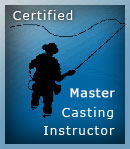What Fly Tackle is Needed to Fish Florida?
I just spent a couple days visiting some friends that own fly shops in the Pocono Mountain region of Northeastern Pennsylvania. On the way, I stopped to take pictures of a small lake I used to fish when the water was hard. The thirteen-degree thermometer reading assured the only fisherman getting his gear ready that he would have, “safe ice.” Ice fishing is one thing I will never do again! The feeling that I used to get when rolling down my car window as I drove to Florida from the freezing north was almost worth the monotonous I-95 drive.
Saturday morning in several shops was devoted to fly tying lessons. Both beginner, and advanced classes were given with an emphasis on freshwater trout fishing. During one of the breaks, a discussion began about what equipment would be required to do some fishing in Florida. Would it be necessary to get new gear in order to do some productive fishing while visiting the Sunshine State?
The first fly beginners were tying was a wooly bugger. This pattern is very easy to tie and a very good early trout season producer when water is a little high and cold. As trout streams warm, it is a great choice for small and largemouth bass that are plentiful in nearby rivers and lakes. A seducer, a very popular saltwater pattern, is essentially a wooly bugger with a long tail. Clouser minnows, another easy pattern, are also effective in both fresh and saltwater. We determined that with a few color modifications and hook sizes, these two patterns could fulfill most saltwater needs, The subject of leaders was mentioned next.
Heavy trout or bass tapered leaders are suitable for most of our shallow water needs. The addition of a twenty, or thirty-pound shock tippet, to a regular ten or twelve-pound class tippet would prevent some of our toothy predators, like snook, ladyfish, and baby tarpon from breaking off. A nine-foot over all length is adequate for most shallow water applications.
When I mentioned shallow water, the term I was hearing most, when referring to fishing the salt was, deep sea fishing. This may explain why most fisherman use tackle that is too heavy. Just look at some of the spinning gear that travels through our airports this time of year. Rod, and line selection don’t have to be heavy. If you have a seven-weight rod with matching weight forward floating line, you are going to be properly equipped to fish most shallow water. An eight, or nine weight, nine footer, will put you in much better shape to cope with our ever present wind. I prefer faster action rods. This allows a better pickup of a long line and helps when making long casts. If the wind is a problem, select a fishing area that is more in the lee.
If you don’t have a good reel, get one! A smooth, adjustable drag is essential. Capacity for at least one hundred yards of backing, before the fly line is put on, will be your insurance when you get a screaming run from some of our fish. They will swiftly head for deep water protection in response to your hook set.
Visit, or call ahead, a fly shop in the area you are interested in fishing. They will be very helpful in getting you started. Hiring a guide for your first day of fishing is one of the best ways to shorten your learning curve.
This article should whet your appetite for a venture into your first saltwater experience. Don’t make the mistake of sitting in the sun watching everyone else enjoy our great fishing while you think about your tackle sitting in your garage back home.
![]()



